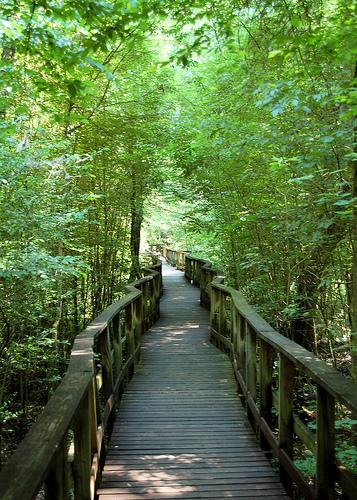Though a veritable youngster in the national park realm, Congaree National Park is a vegetative museum, harboring some of the eastern United States' tallest trees in what's said to be the largest old-growth bottomland hardwood forest in the country.
Bald cypress, water oak, sycamore, tupelo and cottonwood are among the trees you'll find in this 24,395-acre park that wraps a section of the Congaree River in central South Carolina. According to the National Park Service, the average canopy height in the park rises above 100 feet. Congaree has one of the tallest temperate deciduous forests in the world -- it's taller than the old-growth forests found in Japan, the Himalayas, southern South America. and all of Eastern Europe. The National Champion Loblolly Pine is located in Congaree. It climbs to 167 feet and is almost 15 feet in circumference.
As with many national parks, Congaree started out as a national monument, receiving that designation in October 1976, and in 1983 it was designated an International Biosphere Reserve by the United Nations Educational, Scientific and Cultural Organization.
On November 10, 2003, the national park designation was conferred on Congaree, making it the 57th "national park" in the country. Today marks its 4th birthday.
Though one of the smallest national parks in acreage, Congaree carries a lot of human, and natural, history with it.
The Congaree Indians claimed the floodplain until European explorers arrived on the continent. About 1700, the Congarees were decimated by a smallpox epidemic introduced with the arrival of European settlers. These new residents obtained land grants from the King of England until 1776, when the state of South Carolina assumed the right to distribute ownership of the land. During the Revolutionary War, Francis Marion, better known in today's history books as "the Swamp Fox," eluded British troops in the Congaree Swamp.
In his Internet course on national parks, Dr. Robert Janiskee, a distinguished professor emeritus in the Geography Department at the University of South Carolina's Columbia campus, teaches his students that "at least 170 species of birds can be seen in the park, including permanent residents, summer species, and fall/winter species. Among the wading birds, songbirds, woodpeckers, raptors, and other birds that can be seen in Congaree at one time of the year or another are barred owls, turkeys, wood ducks, blue herons, red-shouldered hawks, various warblers, and swallow-tailed kites.
"In addition to 49 or more species of fish, there are at least 53 reptile and amphibian species. Due to the abundance of wet or moist areas, amphibians such as the spotted turtle are plentiful. Though not as abundant as many people think, snakes are fairly common in Congaree. Most are non-venomous species such as the king snake and the pinewood snake, but there are four venomous species as well – copperhead, canebrake rattlesnake, cottonmouth, and coral snake (rare). Fish such as gar and largemouth bass live in the streams and ponds. Many mammal species are year round residents of the park, including white-tailed deer, feral hog, raccoon, gray squirrel, and marsh rabbit."
To this list you might one day be able to add the Ivory-billed Woodpecker, as there have been unconfirmed sightings of this rare bird in the park.
Visitors to Congaree can explore the park by kayak or canoe on the water trail that follows Cedar Creek, the largest channel through the floodplain. There are a variety of hiking options through the park, ranging from elevated boardwalks to the 11-mile-long King Snake Trail that is popular with birders and those in search of some of the park's wildlife.
Backcountry and canoe camping are allowed in the park, and there are two designated group campgrounds, the Bluff and After Hours campgrounds.
There presently is no entrance fee at the park.


 Support Essential Coverage of Essential Places
Support Essential Coverage of Essential Places







Comments
My class is currently doing research project on National Parks. My group and I chose the Congaree, looking to learn something new. Thank you, Mr. Repanshek, for writing this article. It was very helpful. :-)